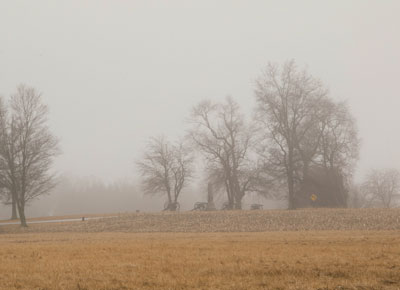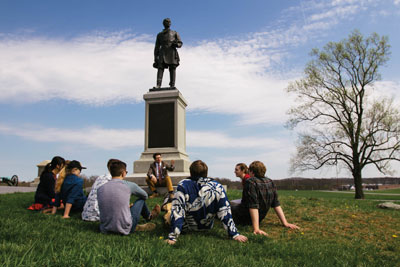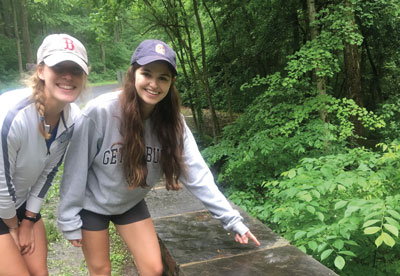
For some courses in art, science, and the social sciences as well as history Gettysburg’s momentous battlefield becomes the College’s largest classroom.
At dawn at Gettysburg National Military Park (GNMP), a mist hangs over the crags of Devil’s Den, the slope of Little Round Top, the headstones of the national cemetery, the blossoms of the apple trees, and the looming monuments. Against this backdrop, visitors—including Gettysburg College students and faculty—reflect on the bloodiest of Civil War battles and contemplate its historical reverberations.
Mere steps from the College, the park is fertile ground for history scholars. Its role as a living laboratory for disciplines beyond history may be surprising. Learning through observation and experience is a core tenet of a Gettysburg College liberal arts education. The GNMP provides students and faculty personal, hands-on connections to learning and research in history— as well as science and the arts.
A Scientific Connection
History buffs, here’s a test: did you know the battlefield is a prime site for studying geology of the Mesozoic Era? Or that the stones on the bridge near Big Round Top are embedded with dinosaur prints? Many students at Gettysburg College are intimately aware of these facts from their fieldwork in geology, ecology, and environmental sciences.
“Ecology is the study of interactions between species and their environment, but even the most basic concepts can seem rather arcane until students are able to witness them in the field,” said environmental studies Prof. Andrew Wilson. Wilson uses the park in his Principles of Ecology and Environmental Science and Society classes. In the latter, students set up cameras to capture nocturnal wildlife in their natural habitats. “The camera- trapping project allows students to think carefully about how to gather information on species that are difficult to observe and promotes learning through experience,” said Wilson.
“Students are generally quite naïve to just how much wildlife there is right on their doorstep. It is eye-opening for them to learn that they can leave the camera to gather scientific data 24 hours a day while they are getting on with their lives minutes away.”
Students are generally quite naïve to just how much wildlife there is right on their doorstep.
Alyssa Kaewwilai ’20 found it “exciting to see new forms of wildlife while being able to appreciate the Gettysburg landscape from an entirely new perspective.” Kaewwilai was also a student in Wilson’s Principles of Ecology class, in which students take part in a three-week field lab. During the first week, they visit an older field habitat to measure tree and shrub density, diversity, patchiness, and canopy cover. During week two, they visit a mature woodland and take similar measurements. During the final week, the class conducts statistical analyses to see how the patterns and diversity of trees and shrubs differ.
“The students gain an understanding of the ecological process that causes successional change from open field through to a mature forest,” said Wilson. “It’s also a great way of introducing various sampling techniques and getting students to think about study design.”
Kaewwilai said she worked with new equipment, such as spectrometers that measure the intensity of light, while also learning how to incorporate gridding into the evaluation of tree species.
The chatter of Wilson’s Principles of Ecology class can be overheard by the students in environmental studies Prof. Sarah M. Principato’s Earth System Science class, as their fieldwork often overlaps.

In Principato’s class, environmental science collides with history. Students learn about the geologic history of the area then study how the different rock types make up the topography of the battlefield and how they influenced the Battle of Gettysburg. From the vantage points of Seminary Ridge, Devil’s Den, and the Overlook Tower, students learn about the geology of the area long before the Civil War: when dinosaurs roamed the earth and when Pangaea began to break apart into the continents.
Gettysburg is part of a failed rift basin; several failed rift basins are present along the east coast of the United States. “When rifting occurred, a large rift basin (i.e. lake) formed, which created the sedimentary rocks in the Gettysburg area,” explained Principato.
Some of the rocks had magma pushing up through them, which created the igneous rock called diabase. The important areas of high elevation are composed of diabase, which withstands weathering better than sedimentary rocks.
“My students can see that the layers of rock are mostly at an angle, signaling that there has been tectonic activity. That’s a real ‘aha’ moment for them, like, ‘Oh, wow, the earth was moving!’”
Examining the signs of eras past and gathering data on the battlefield’s periglacial boulders, said Marion McKenzie ’19, is “incredibly useful in visualizing the glacial history of Gettysburg, while gaining critical field experience in environmental studies.”
The Landscape as Teacher
For history and social science scholars, the landscape of the battlefield provides different lessons.
Civil War Era Studies Prof. Peter Carmichael, director of the Civil War Institute (CWI), brings his students to the battlefield to read the letters and journals of the soldiers— on the grounds on which they felt, fought, and often perished in 1863.
“These moments on the battlefield are powerful for students, who can feel the presence of the past, whether it is at an obscure grave site at Culp’s Hill or at a more popular tourist haunt like Little Round Top,” Carmichael said. “They discover that the words of a single soldier offer a pinhole through which to explore the broader social and political currents of the Civil War. They see that the battlefield is not just a chessboard of tactical moments.”
These moments on the battlefield are powerful for students, who can feel the presence of the past...
Carmichael said his students’ observations were critical to his own thinking while writing his book, The War for the Common Soldier: How Men Thought, Fought, and survived in Civil War Armies, published this fall, which is inspired by the stories of pain, loneliness, boredom, trauma, family, and death from everyday soldiers. He commented that students are “quick to point out that there is no single narrative of the soldier experience at Gettysburg and that soldiers could occupy the same space at the same moment and make very different meanings about what was endured.”
Abigail Cocco ’19, a history major and CWI Fellow, said that accessing the battlefield through classes with Carmichael and her work with the CWI brought added depth to her educational experience, inspiring her to be a better historian.
“Reading about the brutality of war and about the number of casualties can be moving, but it is not nearly as provocative as looking out into Iverson’s Pits and seeing exactly where 900 men were killed, wounded, or captured in a span of 20 minutes,” she said. “The strong feelings and emotions the landscape evokes inspires in me, as a historian, a sense of duty to think deeply about history, memory, and the implications of both.”
“Abby has learned to ask the difficult questions of history and to challenge her audience to think outside the box,” said Carmichael. “That’s what we want from Gettysburg College students.”
Associate Director Jill Ogline Titus and Assistant Director Ashley Whitehead Luskey of the CWI are working with Cocco and other Fellows to develop wayside markers for the GNMP, a project that Ogline Titus said “allows students to strengthen their research skills and learn how to apply them to a ‘product’ different than the long-form research papers they write in the classroom.”
For CWI Fellow Jeffrey Lauck ’18, the wayside project was an opportunity to add nuance to the experience that visitors have at the park. “For many visitors—especially those who don’t know a whole lot about the Civil War—wayside exhibits and other on-site interpretations can play a huge role in their understanding of the Civil War,” said Lauck. “One of the goals of the project is to complicate the public discussion of the Civil War by telling stories that are often lost in the traditional ‘chessboard’ interpretation.” During his time as a Fellow, Lauck helped create wayside exhibits on the dedication of Confederate monuments on the battlefield and African Americans’ experiences during the battle.
The Fellows also worked on a digital mapping project called Killed at Gettysburg (KAG), which tells soldier stories from multiple angles—their family and community backgrounds, why they fought, and the impact of their deaths on family and community. Luskey noted that she encourages the CWI Fellows to use their soldiers’ stories as a window into bigger ideas or themes about the Civil War era. The project is available to the public online.

“By connecting specific, tangible places on the battlefield with much broader, intangible ideas about the long Civil War era, students are better able to understand the significance of the historic landscape and the worldviews of those who fought upon it,” Luskey said. “Through the soldier profiles they create for the KAG website, they help the public achieve a richer understanding of why these men, their actions, and this battlefield mattered— and still matter to us today.”
Cocco’s solider was George Buck. “Through this type of experiential learning, I became intimately familiar with the action that occurred at Little Round Top in a way I couldn’t have otherwise,” said Cocco.
For the KAG project, Cocco and her peers used primary sources, such as military service records, widow’s pension records, regimental histories, census records, and newspapers to flesh out pre-war and pre-Gettysburg experiences. They used books and maps to find the battlefield locations where key events happened for their men and took photographs of the major landscapes that featured into their assigned soldier’s battlefield story.
Experiential learning such as this requires immersion in a topic, naturally leading to a deeper level of analysis. History Prof. Ian Isherwood ’00 said a central goal of a liberal arts education is to instill critical thinking skills. “It’s our job as faculty to encourage our students to learn new ways of approaching the past through its tangible symbols in our community,” he said.
As another example demonstrating the instructional value of Gettysburg’s landscape, Isherwood has his students conduct deep readings of Civil War letters while overlooking the fields of Gettysburg. In his First-Year Seminar, students use the letters to reflect on individual trauma, probe the meaning of monuments through the decades, and write reflections on sacrifice while viewing the headstones at the Gettysburg National Cemetery. He noted, “When you are between the ages of 18 and 25—prime military service age—the cemetery takes on a particular resonance. Students reflect on their own lives at a leafy liberal arts institution and juxtapose that with the sacrifices that soldiers their age were making in the past. It’s a powerful moment for them.
Students tour battlefield topography to learn how and why strategic military choices were made during the Civil War—an experience that cannot be replicated in a classroom. In Isherwood’s History 219 course titled The Great War, he teaches students about military tactics—not the tactics of the Civil War, but those of World War I. Students learn about the 1917 World War I mobilization that occurred on the Gettysburg campus and battlefield.
Danielle Jones ’18 led her peers in a tactical demonstration for the Great War class on Gettysburg College’s athletic fields. She ordered her classmates to leave the trenches and attack based on the actual maneuvering of a historical battle.
“It was really interesting to experience the tactical transitions as opposed to just reading them on paper. It helped all of us realize how much more chaotic trying to carry out orders and keep men together had to have been on an actual battlefield.” Juliette Sebock ’17, an alumna of the class, agreed: “There,s so much power in actually seeing these troop movements done by people, rather than on a map.”
ROTC Cadet Jared McCully ’19 uses the battlefield weekly—conducting ROTC runs and delivering leadership lessons to cadets, educating them about a significant moment or person related to Gettysburg. McCully has built his own major called War Studies. “The use of the physical battlefield is possibly the best classroom available on campus,” said McCully. “To have the ability to retrace the steps of the battle and use the lessons from an event that happened 155 years ago is extremely rare to find on a college campus.”
To have the ability to retrace the steps of the battle and use the lessons from an event that happened 155 years ago is extremely rare to find on a college campus.
As a student, Kevin Lavery ’16 appreciated that Isherwood’s classes used the tactile battlefield and monuments to complicate the concepts of valor and heroism, question how historical narratives change over time, and probe the meaning of national symbols. “A statue is never just a statue; a flag is never just a flag. Prof. Isherwood taught us that the battlefield is more than a historic resource; it is a cultural touchstone to be explored deeply and challenged constantly by students.”
Blurring the Truth
Challenging assumptions is integral to a Gettysburg College education. In Prof. Jill Ogline Titus’s class, Rewriting the Past: Historical Fiction and History, she teaches excerpts from The Killer Angels by Michael Shaara, a novel that may be the best-known and most widely read book ever written on the Battle of Gettysburg.

Her class visits Little Round Top after reading the novel to probe how the book has shaped popular understanding of the Battle of Gettysburg and the 20th Maine. “Students, like all people, are sensitive to the power of place, and enjoy the opportunity to make connections between ideas, historical experiences, and landscapes,” explained Ogline Titus. While at Little Round Top, students ask challenging questions, such as whether or not the 20th Maine’s action on the hill saved the Union and how literature might blur the truth of real events.
In art as in other disciplines, rigorous thinking and questioning is required, whether the historical context is examined through a contemporary lens or a historical lens is used to study contemporary events.
“War is a frequent motif for artists and a topic of contemplation for students of art and art history,” explained Prof. Shannon Egan, director of the Schmucker Art Gallery.
The art gallery—small, but mighty—hosts eight to 10 exhibits a year and houses major artistic works depicting the battlefield. Many past exhibits have included interpretations or responses to the Gettysburg Cyclorama depicting Pickett’s Charge.
For example, contemporary artist Gregory Thielker installed a panoramic painting of the battlefields and landscape of Afghanistan in homage to the Cyclorama as part of the exhibition “(Un)governed Spaces: A Panorama of Afghanistan” in 2015. CWI students curated an exhibition titled “Visualizing War” in 2012, which featured art and artifacts of scenes from the Civil War, and contemporary artist Michael Scoggins took the scene of Pickett’s Charge and Lincoln’s Gettysburg Address as the subject of two major works in his exhibition “When Johnny Comes Marching Home” in 2014.
Beyond the richness of the museum, art and art history students have immediate access to the park with its picturesque landscapes and 1,328 monuments—an aesthetic feast. Egan’s students spend time there, connecting those visits to “present- day controversies” about Confederate monuments, how histories are made visible (or invisible) through public art, and how artists carefully composed their photographs for political and aesthetic reasons.
Through Egan’s History and Theory of Photography class, Erica Schaumberg ’18, an art history major, said she analyzed the works of Civil War photographers such as Alexander Gardner, Timothy H. O’Sullivan, and Mathew Brady.
The photographs from these artists, taken after the battle, depict the bodies of the dead and the destructive aftermath of the war.
“Many of the photographs taken after the battle were staged or manipulated to create a more dramatic effect,” Schaumberg said. “They pushed my understanding of how, as Americans, we view the war today and how that perception is intertwined with politics, economics, and a sense of celebrity.” It also changed how she approached her own photography of the battlefield.
Schaumberg also took Egan’s Art and Public Policy course and was able to visit the archives in the GNMP. She said access to war-time objects and a close-up view of the Cyclorama “put the battle in perspective” for her in a way reading and the classroom could not.
As dusk descends on the GNMP and the tourists head home, Gettysburg students and faculty continue to muse upon their living laboratory. How did everyday soldiers feel contemplating the same moon back in 1863? Will the camera traps capture the mysterious nocturnal movements of the battlefield wildlife? In what ways will future artists be inspired by the landscapes outside the College’s front door? Every day, the GNMP gives the Gettysburg College community the opportunity to answer these questions and more.